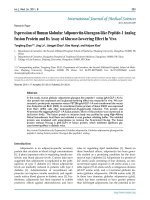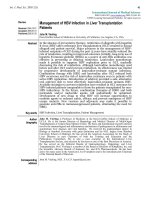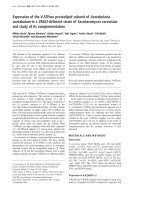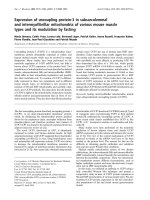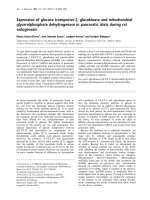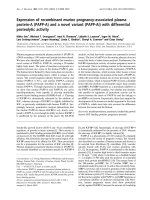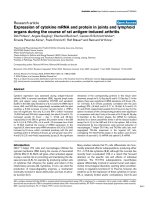Báo cáo y học: "Expression of Human Globular Adiponectin-Glucagon-Like Peptide-1 Analog Fusion Protein and Its Assay of Glucose-Lowering Effect In Vivo"
Bạn đang xem bản rút gọn của tài liệu. Xem và tải ngay bản đầy đủ của tài liệu tại đây (477 KB, 7 trang )
Int. J. Med. Sci. 2011, 8
203
I
I
n
n
t
t
e
e
r
r
n
n
a
a
t
t
i
i
o
o
n
n
a
a
l
l
J
J
o
o
u
u
r
r
n
n
a
a
l
l
o
o
f
f
M
M
e
e
d
d
i
i
c
c
a
a
l
l
S
S
c
c
i
i
e
e
n
n
c
c
e
e
s
s
2011; 8(3):203-209
Research Paper
Expression of Human Globular Adiponectin-Glucagon-Like Peptide-1 Analog
Fusion Protein and Its Assay of Glucose-Lowering Effect In Vivo
Tongfeng Zhao
1
, Jing Lv
1
, Jiangpei Zhao
2
, Xiao Huang
3
, and Haijuan Xiao
1
1. Department of Geriatrics, the Second Affiliated Hospital, School of Medicine, Zhejiang University, Hangzhou 310000, PR
China
2. Department of Geriatrics, Hangzhou Hospital of Traditional Chinese Medicine, Hangzhou 310000, PR China
3. College of Life Sciences, Zhejiang University, Hangzhou 310000, PR China
Corresponding author: Tongfeng Zhao, Ph.D., Department of Geriatrics, the Second Affiliated Hospital, School of Medi-
cine, Zhejiang University, Hangzhou 310000, PR China. Tel: 86-571-887783690; Fax: 86-571-87022660; e-mail:
© Ivyspring International Publisher. This is an open-access article distributed under the terms of the Creative Commons License (
licenses/by-nc-nd/3.0/). Reproduction is permitted for personal, noncommercial use, provided that the article is in whole, unmodified, and properly cited.
Received: 2010.11.17; Accepted: 2011.03.01; Published: 2011.03.04
Abstract
In this study, human globular adiponectin-glucagon-like peptide-1 analog (gAd-GLP-1-A) fu-
sion protein was expressed and its glucose-lowering effect was measured in vivo. We con-
structed a prokaryotic expression vector PET28a-gAd-GLP-1-A and transformed the vector
into Escherichia coli BL21 (DE3). A recombinant fusion protein of about 25KD was expressed
from BL21 (DE3) cells after isopropylthio--D-galactoside induction. This protein was
N-terminal His-tagged gAd-GLP-1-A fusion protein. Most of the protein was expressed in
inclusion body. The fusion protein in inclusion body was purified by using High-Affinity
Nickel Iminodiacetic Acid Resin and refolded in urea gradient refolding buffer. The refolded
protein was incubated with enterokinase to remove the N-terminal His-tag. The fusion
protein without His-tag is gAd-GLP-1-A fusion protein, which exhibited significant glu-
cose-lowering effect in diabetic mice.
Key words: Escherichia coli, Expression, Globular adiponectin, Globular adiponectin-glucagon-like
peptide-1 analog fusion protein, Glucagon-like peptide-1 analog
Introduction
Adiponectin is an adipocyte-specific secretory
protein that circulates in blood at high concentrations
[1]. It plays important roles in regulating insulin sen-
sitivity and blood glucose levels. Current data have
suggested that adiponectin is implicated in the path-
ogenesis of type 2 diabetes [1]. Blood adiponectin
levels are markedly reduced in patients with type 2
diabetes [1]. Administration of recombinant adi-
ponectin can improve insulin sensitivity and signifi-
cantly reduce blood glucose in diabetic mice [1]. Fur-
thermore, adiponectin has been reported to exhibit
protective effects against atherosclerosis and have
roles in regulating lipid metabolism [1]. Based on
these beneficial effects, adiponectin has been gener-
ally studied as a promising candidate for the treat-
ment of type 2 diabetes [1]. Adiponectin is a protein of
247 amino acids consisting of four domains, an ami-
no-terminal signal sequence (1-18 amino acid), a var-
iable region (19-41 amino acid), a collagenous domain
(42-107 amino acid), and a C-terminal globular do-
main (globular adiponectin, 108-244 amino acid) [2].
In these four domains, globular adiponectin (gAd),
which has been confirmed to have greater potency
than full-length adiponectin, has the potential to be-
Int. J. Med. Sci. 2011, 8
204
come a novel therapeutic agent for the treatment of
type 2 diabetes [2].
Glucagon-like peptide 1 (GLP-1) is an incretin
hormone released from islet -cell and intestinal
L-cells in response to the ingestion of food [3]. It plays
an important role in glucose homeostasis and has
shown promising effects as a new treatment for type 2
diabetic patients [3]. The main function of GLP-1 is to
enhance glucose-dependent insulin secretion [3].
Administration of GLP-1 can increase insulin secre-
tion and reduce blood glucose [3]. GLP-1 also pro-
motes islet β-cell proliferation, suppresses glucagon
secretion, reduces hepatic glucose production, inhibit
appetite, and slow the rate of gastric emptying [3].
GLP-1 (1-37), the intracellular precursor of GLP-1, is
cleaved from proglucagon, and the first six amino
acids are subsequently removed from the
N terminus
to form bioactive peptides [4]. The principal biologi-
cally active forms of GLP-1 are: GLP-1 (7-37) and the
predominant circulating active form GLP-1 (7-36)
amide [4]. In vivo, both peptides have equipotent bi-
ological effects [4]. However, the potential for using
GLP-1 to lower blood glucose is limited by its very
short plasma half-life [5, 6]. This is due to its rapid
inactivation by dipeptidyl peptidase IV and by renal
clearance. Developing long-acting GLP-1 analogs
(GLP-1-A) to circumvent the rapid inactivation and
renal clearance of GLP-1 is therefore an important
step toward applying them therapeutically [5, 6].
Type 2 diabetes is characterized by insulin re-
sistance and insulin secretion deficiency. At present,
there is no a single medication which treats type 2
diabetes by improving both insulin resistance and
insulin secretion deficiency. This study was designed
to express human globular adiponectin-glucagon-like
peptide-1 analog (gAd-GLP-1-A) fusion protein from
Escherichia coli strain BL21 (DE3) and investigate its
glucose-lowering effect in diabetic mouse model. The
GLP-1-A, which should have greater plasma stability
and longer biological half-life, was generated by a
substitution of glycolamine for alanine at the second
site of GLP-1 (7-37) [7].
Materials and medhods
Materials
Male KM mice (weight 18-20g) were provided by
Experimental Animal centre, Zhejiang Chinese
Medical University (Hangzhou, China). Plasmid vec-
tor PET28a and Escherichia coli host strain BL21 (DE3)
were obtained from Zhejiang University Institute of
Life Sciences (Hangzhou, China). Mouse anti-His-tag
monoclonal antibody was purchased from Novagen
Company (Germany). Streptozocin was obtained
from Sigma Company (USA). High-Affinity Nickel
Iminodiacetic Acid (Ni-IDA) Resin and enterokinase
were the products of GenScript Corporation (USA).
BCA Protein Assay Kit was purchased from Beyotime
Institute of Biotechnology (Jiangshu, China).
Construction of recombinant vector
PET28a-gAd-GLP-1-A
Recombinant vector PET28a-gAd-GLP-1-A was
constructed according to previous method established
by our laboratory (Patent No: 200510050844.8) [8].
Briefly, GLP-1-A gene was obtained by designing a
mutation in the gene of GLP-1 (7-37). This mutation
resulted in the substitution of glycolamine for alanine
at the second site of GLP-1 (7-37) peptide. A sequence
of nucleotide including 45 bases was used to connect
the 3’ terminus of GLP-1-A gene and 5’ terminus of
gAd gene. The product of this nucleotide sequence
was a glycine-rich short peptide including 15 amino
acids: [N-(Serine-glycine)
7
- Serine-C], which was used
as a linker to connect the N-terminus of gAd and the
C-terminus of GLP-1-A. Because the protein produced
from plasmid vector PET28a was an N-terminal
6×His-tagged protein, we introduced an enterokinase
cleavage site at the 5’ terminus of the gene of
gAd-GLP-1-A fusion protein, which was used to re-
move the N-terminus His-tag [9]. The gene encoding
the gAd-GLP-1-A fusion protein was cloned into the
expression vector PET28a at Nhe I and HindIII sites.
Expression of N-terminal His-tagged
gAd-GLP-1-A fusion protein and Western blot
analysis
Protein expression: The Escherichia coli BL21
(DE3) transformed with PET28a-gAd-GLP-1-A were
spread in Luria-Bertani liquid medium (1% tryptone,
1% NaCl, 0.5% yeast extract, w/v, pH 7.0) supple-
mented with 80mg Kanamycin /l and cultured over-
night at 37°C. Typically, 2mL of overnight grown
culture was added to 200mL of medium and incu-
bated with shaking at 37°C until optical density at 600
nm reached 0.4-0.6. Isopropylthio--D-galactoside
(IPTG) was then added to a final concentration of
0.4mM and bacterial were cultured for additional 4h
at 37°C in shaking incubator to induce the His-tagged
gAd-GLP-1-A fusion protein expression. Bacterial
cells were harvested by centrifugation at 5000 rpm for
10 min at 4°C, washed with 0.1M phosphate-buffered
saline (PBS, pH 7.4) for three times. The sediments
were resuspended with 0.1 M PBS, sonicated on ice
for 30min, and then recentrifuged in order to separate
the supernatant and inclusion body. Part of the pro-
duction was applied to a 12% SDS–PAGE.
Western blot analysis: The supernatant and in-
Int. J. Med. Sci. 2011, 8
205
clusion body were analyzed by 12% gels SDS–PAGE,
and then transferred to a nitrocellulose membrane
(1h, 100V). Following transfer, the membrane was
blocked in Tris Buffered Saline with Tween-20 con-
taining 50g/L skimmed milk for 2h, and then incu-
bated with mouse anti-His-tag monoclonal antibody
for 2h at room temperature. The strips were washed
three times with Tris Buffered Saline (5min each time)
and then incubated with horseradish peroxi-
dase-conjugated second antibody for 2h, washed
again with Tris Buffered Saline as described previ-
ously, and finally developed with
5-Bromo-4-Chloro-3-Indolyl Phosphate /Nitro blue
tetrazolium solution.
Purification and refolding of N-terminal
His-tagged gAd-GLP-1-A fusion protein
The inclusion body were washed in washing
buffer I (0.5% Triton X-100, 50mM Tris-HCl, 10mM
EDTA, pH 8.0) for three times, and then in washing
buffer II (2M urea, 50mM Tris-HCl, 10 mM EDTA, pH
8.0) for two times. The sediment was dissolved in
Binding Buffer (5mM imidazole, 0.5M sodium chlo-
ride, 20mM Tris, 8M urea, pH 7.9) at 4°C for about 2h.
The insoluble materials were removed by centrifuga-
tion at 12000g at 4°C for 15 min. The N-terminal
His-tagged gAd-GLP-1-A fusion protein was dis-
solved in the supernatant. The fusion protein was
purified by High-Affinity Ni-IDA Resin. The column
was equilibrated with 4 bed volumes of Ly-
sis-Equilibration-Wash (LEW) buffer (50mM sodium
dihydrogen phosphate, 300mM sodium chloride, pH
8.0), and the cleared sample containing N-terminal
His-tagged gAd-GLP-1-A fusion protein was applied
to the column, followed by washing with 8 bed vol-
umes of LEW buffer to remove the unbound protein.
The target protein was eluted with 5-10 bed volumes
of elution buffer (50mM sodium dihydrogen phos-
phate, 300mM sodium chloride, 250mM imidazole,
8M urea, pH 8.0). At last, fractions containing pure
target protein were collected and analyzed by
SDS–PAGE.
The purified N-terminal His-tagged
gAd-GLP-1-A fusion protein containing 8M urea was
then refolded in urea gradient (6, 4, 2, 1 and 0 M) re-
folding buffer (20mM Tris-HCl, 1mM EDTA, 0.2mM
oxidized glutathione, 2mM reduced glutathione, 0.6M
L-arginine, 10% glycerin) at 4°C. The buffer was
changed every 12h. The protein concentration was
measured by BCA Protein Assay Kit. PEG20000 was
used to concentrate the refolded protein.
Removal of N-terminal His-tag
The refolded protein was incubated with enter-
okinase (1U enterokinase was added in 0.5mg re-
folded protein) at 22°C for 16h to produce
gAd-GLP-1-A fusion protein. The digested products
were analyzed by SDS-PAGE and Western blot anal-
ysis.
Assay of glucose-lowering effect of gAd-GLP-1-A
fusion protein
Male KM mice were housed at 23-25°C in a
12-hour light/dark cycle with access to standard
powdered mice chow and normal water. The scientific
project, including animal care was supervised and
approved by Animals Ethics Committee of the Second
Affiliated Hospital, Zhejiang University. They were
allowed one week to adapt to their environment be-
fore the experiment. And then, the mice were ran-
domly divided into three groups: normal control
group, diabetic control group, and diabetic treated
group. Each group included 8 mice. Diabetes was
induced in mice by a single intraperitoneal injection of
streptozotocin (150 mg/kg body weight, dissolved in
sodium citrate buffer) after overnight fasting [10].
Mice in normal control group were treated with so-
dium citrate buffer. 72h after injection, the mice with
fasting blood glucose higher than 200 mg/dl were
considered as successfully diabetic model mice. After
overnight fasting, the mice in diabetic treated group
were treated with 15mg/kg body weight of
gAd-GLP-1-A fusion protein by intraperitoneal injec-
tion. The mice in diabetic control group and normal
control group were treated with the same volume of
normal saline. Blood glucose was respectively meas-
ured at 30min, 1h, 1.5h, 2h, 2.5h and 3h after injection.
Statistical analysis
Data were expressed as means ± standard devi-
ations. Data were analyzed using one-way analysis of
variance and secondary analysis for significance with
the Turkey-Kramer post test. All analyses were per-
formed using SPSS version 11.0 (SPSS Inc., USA). P
<0.05 was considered statistically significant.
Results
Expression of N-terminal His-tagged
gAd-GLP-1-A fusion protein and Western blot
analysis
The Escherichia coli host strain BL21 (DE3) cells
transformed with the expression vector
PET28a-gAd-GLP-1-A produced a recombinant fu-
sion protein of about 25KD after IPTG induction. The
protein consists of four domains: 6×His-tag, entero-
kinase cleavage site (DDDDK), GLP-1-A (31 amino
acids), linker (glycine-rich short peptide, 15 amino
acids), and gAd (137 amino acids) (Fig. 1A). The fu-
Int. J. Med. Sci. 2011, 8
206
sion protein was absent in non-induced condition.
SDS-PAGE analysis showed that most of the fusion
protein was in inclusion body (Fig. 2A). Western blot
using mouse anti-His-tag monoclonal antibody also
proved that majority of fusion protein was present in
inclusion body (Fig. 2B).
Figure 1 Maps of N-terminal His-tagged gAd-GLP-1-A fusion protein and gAd-GLP-1-A fusion protein. (A) N-terminal
His-tagged gAd-GLP-1-A fusion protein; (B) gAd-GLP-1-A fusion protein.
Figure 2 Expression of N-terminal His-tagged gAd-GLP-1-A fusion protein. Before IPTG induction, part of Escherichia coli
BL21 (DE3) transformed with recombinant vector were collected and lysed. The lysate was analyzed by 12% SDS-PAGE.
After IPTG induction, the Escherichia coli BL21 (DE3) transformed with recombinant vector were sonicated and centrifuged
to separate the supernatant and inclusion body. Part of the production was applied to 12% SDS–PAGE analysis and
Western blot analysis. (A) SDS-PAGE analysis: Most of the fusion protein was found in inclusion body. The expected
molecular weight of the fusion protein is about 25KD. M: protein molecular weight marker; Lane 1: inclusion body; Lane 2:
bacterial cell lysate before IPTG induction; Lane 3: supernatant. (B) Western blot analysis: Mouse anti-His-tag monoclonal
antibody was used for this analysis. The fusion protein was observed in both inclusion body and supernatant. But most of
them were in inclusion body. Lane 1: inclusion body; Lane 2: supernatant.
Int. J. Med. Sci. 2011, 8
207
Purification and refolding of N-terminal
His-tagged gAd-GLP-1-A fusion protein
The fusion protein was purified by High-Affinity
Ni-IDA Resin. After filtering, the fusion protein was
bound in the column. The column was washed by
LEW buffer to remove the unbound protein. And
then, elution buffer was used to elute the fusion pro-
tein. The results were analyzed by 12% SDS-PAGE
gel. No fusion protein was found in LEW buffer after
washing the column (Fig. 3). However, we detected
the fusion protein in elution buffer (Fig. 3). The puri-
fied N-terminal His-tagged fusion protein was then
refolded by urea gradient refolding buffer.
Figure 3 SDS-PAGE analysis for the purification of
N-terminal His-tagged gAd-GLP-1-A fusion protein. M:
protein molecular weight marker; Lane 1: purified protein in
elution buffer; Lane 2: LEW buffer after washing column.
Enterokinase cleavage of the N-terminal
His-tagged gAd-GLP-1-A fusion protein
To obtain functional gAd-GLP-1-A fusion pro-
tein, the His-tag must be removed from the
N-terminal His-tagged gAd-GLP-1-A fusion protein.
Enterokinase can recognize the sequence
Asp-Asp-Asp-Asp-Lys (DDDDK) and cleave the pep-
tide bond after the lysine residue [9]. The enzyme can
cleave any fusion protein that carries this sequence
[9]. The N-terminal His-tagged gAd-GLP-1-A fusion
protein was incubated with enterokinase to remove
the N-terminal His-tag. An approximately 22KD
cleavage fragment was observed after the incubation,
which was analyzed by SDS-PAGE (Fig. 4A). Western
blot did not detect His-tag reactivity after enteroki-
nase cleavage, which suggested that the His-tag was
removed from the N-terminal His-tagged
gAd-GLP-1-A fusion protein (Fig. 4B). The fusion
protein without His-tag was gAd-GLP-1-A fusion
protein (Fig. 1B).
Figure 4 Enterokinase cleavage of the N-terminal
His-tagged gAd-GLP-1-A fusion protein. (A) SDS-PAGE
analysis: After enterokinase cleavage, we observed a
cleavage fragment of 22KD. The fragment was
gAd-GLP-1-A fusion protein. M: protein molecular weight
marker; Lane 1: after enterokinase cleavage; Lane 2: before
enterokinase cleavage. (B) Western blot analysis: No
His-tag reactivity was detected after cleavage. Lane 1: after
enterokinase cleavage; Lane 2: before enterokinase cleav-
age.
Glucose-lowering effect of gAd-GLP-1-A fusion
protein
We investigated the glucose-lowering effect of
gAd-GLP-1-A fusion protein in diabetic mice. Blood
glucose was respectively measured at 30min, 1h,
1.5h, 2h, 2.5h and 3h after injection the fusion protein.
The results showed blood glucose from diabetic
treated group was lower than that from diabetic con-
trol group. The difference was significant at 2h, 2.5h,
and 3h after injection (P<0.05) (Table 1).
